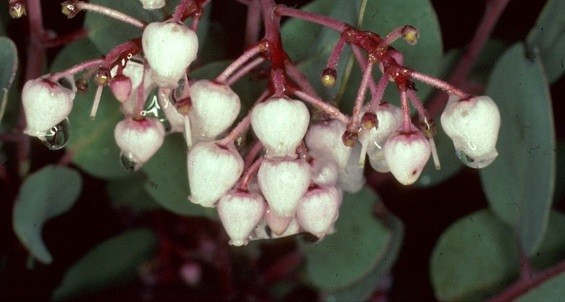Ione manzanita
(Arctostaphylos myrtifolia)

Description
Arctostaphylos myrtifolia is a rare species of manzanita known by the common name Ione manzanita. It is endemic to the Sierra Nevada foothills of California. It grows in the chaparral and woodland plant community on a distinctive acidic soil series in western Amador and Calaveras Counties. There are only about 17 occurrences, but the plant is abundant in some areas of its limited range. This is a federally listed threatened species. Arctostaphylos myrtifolia is a red-barked, bristly shrub reaching just over a meter in maximum height. The small bright green leaves are coated in tiny glandular hairs and are shiny but rough in texture. They are less than 2 centimeters long. The inflorescence is a raceme of urn-shaped manzanita flowers on bright red branches. The fruit is a cylindrical drupe only a few millimeters long. A major threat to this rare endemic plant is a pair of fungal diseases. A branch canker caused by species of Fusicoccum, including F. aesculi, causes some mortality, and root and crown rot caused by Phytophthora cinnamomi has destroyed entire stands of the manzanita and prevented its regrowth in patches of infested soil. These microorganisms, as well as a newly identified one, Phytophthora cambivora, are spreading rapidly and may soon reach the entire range of the plant's distribution. Because of this threat, which may lead to the extinction of the species, the United States Fish and Wildlife Service has recommended that it be upgraded from threatened to endangered status. Arctostaphylos is a genus of plants comprising the manzanitas and bearberries. They are shrubs or small trees. There are about 60 species, of Arctostaphylos, ranging from ground-hugging arctic, coastal, and mountain species to small trees up to 6 m tall. Most are evergreen (one species deciduous), with small oval leaves 1–7 cm long, arranged spirally on the stems. The flowers are bell-shaped, white or pale pink, and borne in small clusters of 2–20 together; flowering is in the spring. The fruit are small berries, ripening in the summer or autumn. The berries of some species are edible. Arctostaphylos species are used as food plants by the larvae of some Lepidoptera species including Coleophora arctostaphyli (which feeds exclusively on A. uva-ursi) and Coleophora glaucella.
Taxonomic tree:







